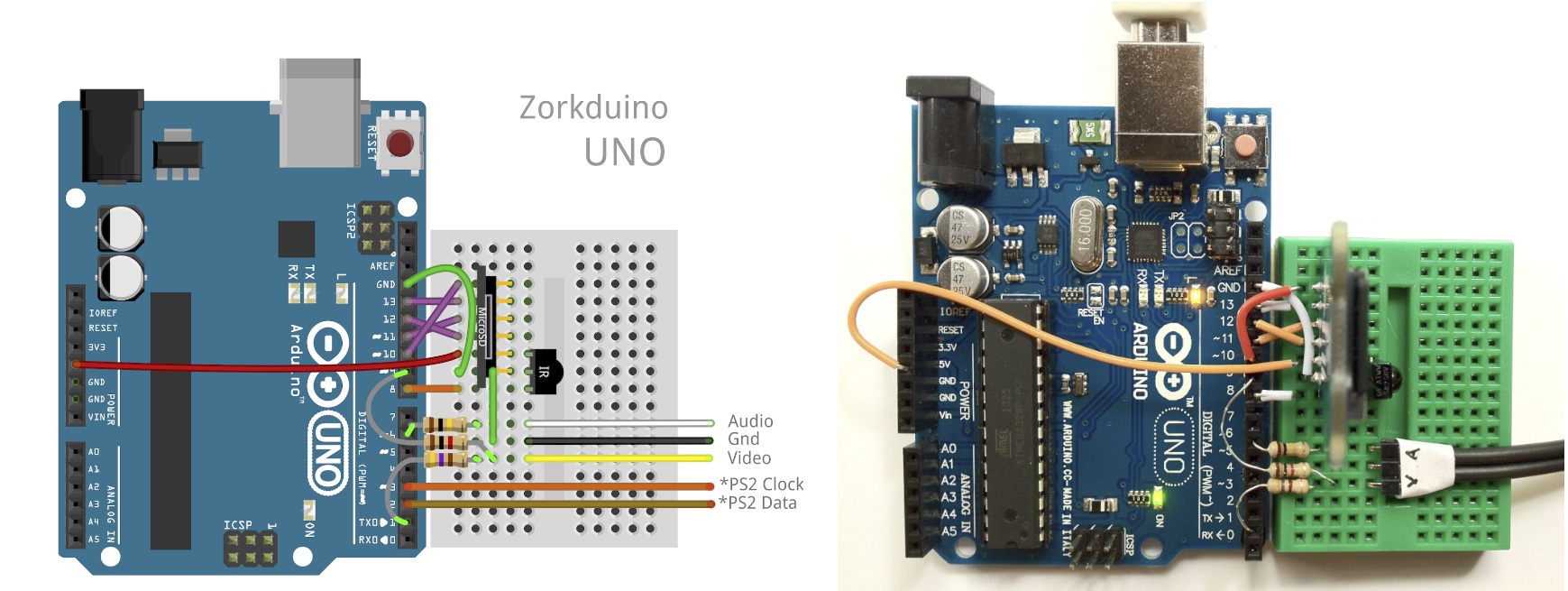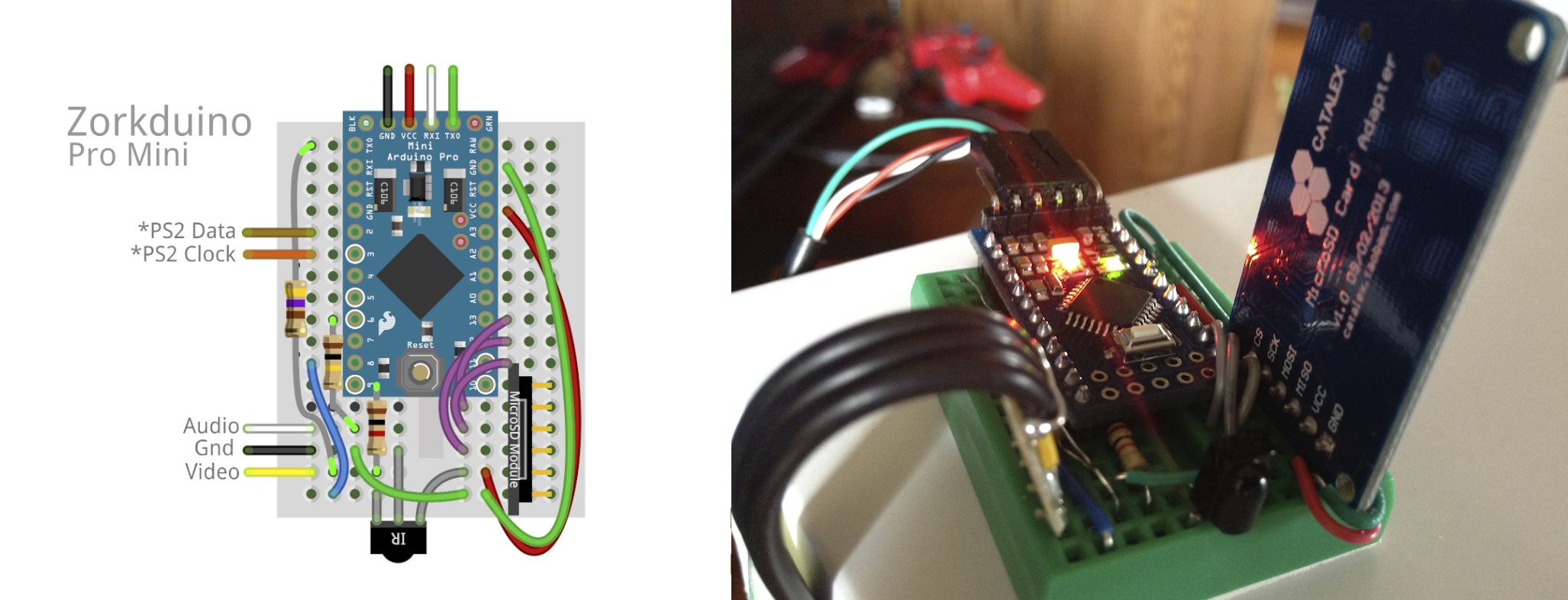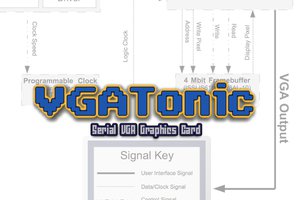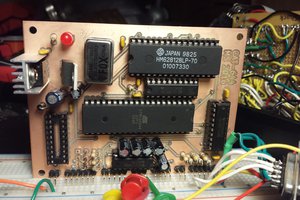
A few years ago I ported a Z-Machine player to a little arduino-like device. Ever since I have been meaning to get around to a project that would work on a TV with a real keyboard and once again rekindle fond memories of long nights playing Zork on my Atari 800.
You will need:
- Arduino UNO, Pro, Pro Mini or equivalent.
- SD card or micro SD card + breakout board (from Adafruit, eBay etc).
- RCA A/V Cable (eBay).
- 470ohm, 1k and 100k resistors.
- Breadboard, wires etc.
- WebTV or MsnTV IR Keyboard or PS2 a nasty old PS2 keyboard (eBay).
- IR receiver TSOP38238,TSOP4838 or equivalent (Adafruit, Mouser etc).
Building it
The schematic is very simple:
+----------------+ +-----------------+
| | | |
| 13 |-----------| SCK micro\SD |
| 12 |-----------| MISO card |
| 11 |-----------| MOSI module |
| 10 |-----------| CS |
| | 5v <-| |
| | GND <-| |
| arduino | +-----------------+
| uno/pro |
| | 5v <--+-+ IR Receiver
| | GND <--| ) TSOP4838
| 8 |-------------+-+
| |
| 6 |----[ 100k ]--------> AUDIO
| |
| 9 |----[ 1k ]----+---> VIDEO
| | |
| 1 |----[ 470 ]----+
| |
| 3 |----------------> *PS2 CLOCK
| 2 |----------------> *PS2 DATA
| |
+----------------+
Layout on an Arduino Uno…

…and on a Mini Pro.

Just about any SD card or microsd card breakout will do. Some of the very cheap ones (<$1) don’t have 5v to 3v3 level converters and may fry your SD card so caveat emptor. As always, Adafruit has nice ones.
WebTV keyboards come in various guises: WebTV, MsnTV, Displayer, UltimateTV etc. They all should work just fine. A few places have the nice Philips variant new for $11.95 w/ free shipping (search for ‘SWK-8630′). This one comes with a nice PS2 IR receiver; more on it later.

IR receivers come in a number of different forms. You are looking for a 38khz version with a known pinout: Some have the center pin as GND, some as V+. Make sure you know what kind you have. When in doubt, Adafruit.
I like using iPhone/iPod video cables for TV projects. Because they no longer work (their MFI chips long since revoked) they are inexpensive, are labeled internally and have a strain relief grommet.
If you have an IR keyboard then good for you. If not, connect your nasty old PS2 clock and data lines to pins 3 and 2 then order an IR keyboard.
Code and Files
https://github.com/rossumur/Zorkduino
The microsdfiles folder contains a zd.mem pagefile along with several sample games:
tutorial.z3 Introduction to interactive fiction and a little bit of Zork I
sampler1.z5Samples of Planetfall, Infidel, and The Witness.
sampler2.z3Samples of Zork I, Leather Goddesses of Phobos, and Trinity
minizork.z3 A nice big chunk of Zork I that was given away with the British Commodore users’ magazine “Zzap! 64″ no. 67. in 1990.
Copy these files to a freshly formatted sd or microsd card. You can find lots of other Zorkduino compatible games at the Interactive Fiction Archive. Insert the card and run the zorkduino.inosketch from the zorkduino folder. When it is all up and running, it should look like this (depending on how many games you found):
How it works
Squeezing Zork into the limited footprint of an Arduino proved to be a bit of a challenge. The code uses a port of Mark Howell and John Holder’s JZIP, a Z-machine interpreter. The Z-machine was created in 1979 to play large (100k!) adventure games on small (8K!) personal computers. Long before Java the implementors at Infocom built a virtual machine capable of paging, loading and saving complete runtime state that ran on a wide variety of CPUs. Clever stuff.
The trouble is the Arduino only has 2k of ram. The Z-machine interpreter uses 2k for its stack alone, leaving no room for dynamic memory, disk buffers, video frame buffers, avr stack and other program state. The solution is to virtualize all stack and memory accesses from the interpreter down to a 160 byte cache and a 512 byte disk buffer. Thats where the zd.mem file comes in – a megabyte or so of virtual stack, memory and save-game slots.
Virtualizing everything slows things down a bit...
Read more » rossumur
rossumur





 PK
PK
 Alexey Voronin
Alexey Voronin
 Mars
Mars
Finally made a page with the Zorkduino Shield: https://hackaday.io/project/20298-zorkduino-shield